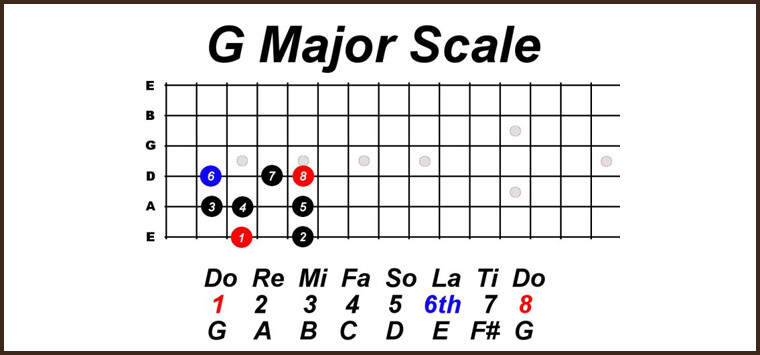
part 1 “the idea”
This subject is going to take a few posts to complete, as it’s a huge subject, simple as it sounds. Let’s call this part 1 – the idea.
Look, look, like it’s all just “do-re-mi man”
That’s what Lenny Breau taught me, the first and only time I got to take a lesson from him. He died shortly after.
If you don’t know who Lenny is, Google him.
You can Watch Lenny here: to give you an idea of the genius of this guy.
Lenny was a man who learned to play guitar by listening to old Les Paul & Mary Ford records…not knowing that the bass, rhythm and lead parts were played by different guys. He thought it was all one guy…and that’s how he learned to play. Session players and teachers from all around would come to see him play to try and figure out how he did what he did. Bass parts and Rhythm parts going in opposite directions (sometimes he would even play 2 time signatures at the same time—freaky!), all while he’s playing a solo on top of it. I have examples of this from a tape recorded seminar Lenny gave at Valley Arts Music, way back when (I think I was 20)…I recorded it, and have since digitized it. I also recorded and digitized the one lesson I got to take from him.
That lesson started exactly as it says above… “look, like…look like…it’s all Do – Re – Mi”… and he proceeded to illustrate what he meant by that. I will try and elaborate on some of what (I think) he meant…but seriously, that one lesson has had the most profound affect on my learning since. Every single year since then, a new door has opened up to me where I’ve had to slap my forehead and say “DAMN!!! He was right! It IS ALL Do-Re_Mi!”
First, he said that “you rockers” use repetitive patterns like 1 – 4 -5 and such. Us Jazzers just use ones like 1-6-2-5-1. Now forget the names do-re-mi from here out, and just think 1 through 8. There are only 8 notes (well…12…but that’s another discussion). Doesn’t matter what key you are in, it all works the same.
Now, for some of you this is very rudimentary… and you can tell, I’m about to dive into what you would call ‘modes’…so maybe this isn’t for you. But that isn’t what he taught me directly. It was more of this concept. If you play just the notes in the scale in thirds (ie: if we’re in the key of G — G B D…then go up one note in the scale and do it again in 3rds…so A C E…it forms chords. When that idea is played through the whole scale you see that the 1 chord is a major chord, then the 2 chord is a minor chord…3 minor, 4 major, 5 major, 6 minor…etc. With the 5, 6 & 7 chords you usually have to alter a note, depending on what you are playing (IE: pure major, minor, dominant 7…etc). That will take some ear training…but eventually that door opens as well. As I practiced this, I would learn the entire scale for the 2 chord, 4 chord, etc… rather than just the triad. And yes, this is the basis of modes. Lenny said this about that… he didn’t necessarily know what mode names went with which position in the scale…he just knew what they sounded like. So I never learned the formal ‘mode’ lesson either. I simply looked at it as utilizing the 2 chord…or the 4 or 5 chord to slip and slide around on until finally winding up back at the root chord.
He wanted me to see EVERYTHING through this lens. Be it trying to learn a song, in the midst of a song looking down the neck, playing solos and trying to think of alternative things to play within the context of a song… this idea that “it’s all just do-re-mi” is beyond helpful in every instance. The idea has helped my students learn ANYTHING they hear by finding the root, and then realizing that what ever key the song is in, the ENTIRE song exists within those 8 notes of that key (not counting modulations of course). The idea has made me see the entire neck of the guitar in new ways. It keeps me from getting stuck repeating patterns too much (a horrible habit) or overusing the pentatonic scale. It makes my musical journey SO MUCH more enjoyable and creative.
A couple of thoughts before I finish this segment off…
1- when soloing, I try and start by creating a repeatable phrase starting from the 2 chord…or the 4 chord…then finish it off with a bluesy pentatonic lick at the root chord. Sometimes I even start from the 7 chord or the 5 chord (the 5 chord works especially well dropping back down to the 1 chord). This sounds like you’re ‘thinking’ a lot, rather than just playing. It just takes the time to practice those scales until they become automatic.
2- another helpful idea is to notice the patterns within the scale. There are always 2 majors in a row, and two minors an a row…usually a step apart (again, changing one note to fit when using the 5-6-7 chord).
3- Sliding in and out of the different positions, playing a few notes from the scale of the 2 chord into the scale of the 4 chord and back to the 1 chord… then try all the scales for each chord of the scale (if that makes sense). I find so many new things to play studying this way…so fun!
Well, that’s it for now. I hope you found a nugget or two in there. More next time!
